“Every once in a while a revolutionary product comes along that changes everything,” Jobs said back then. Featuring a new input technology at the time called “capacitive multitouch” and a single physical button for OS navigation, the phone was destined to start a paradigm shift in the smartphone computing space. But little did the rest of the market know how astonishingly successful the platform would be with mainstream consumers, business professionals and Apple fans all across the globe.
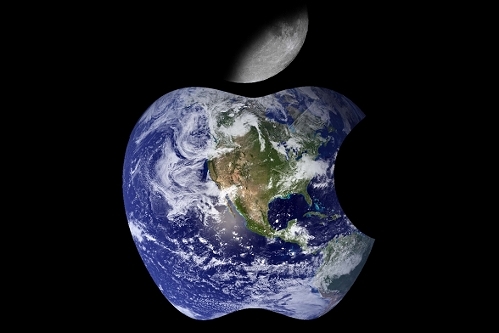
In the first 186 days since release, the original iPhone sold a grand total of 3,704,000 units in the United States by December 30, 2007, averaging to roughly 12,163 iPhones per day. Jobs made it clear during his MacWorld 2008 keynote that his revolutionary device topped smartphone sales by Palm, Nokia and Motorola combined, right out of the gate. For a device that garnered over 20 percent of all US smartphone sales after being on the market for less than a year, it was certainly doing well for itself.
Three years have come and gone since Apple first entered the smartphone business, and with each successive launch of a new iPhone iteration it has seen even higher revenue margins backed by an ever-growing user base. Where its first-generation model released in June 2007 and was available in six different countries respectively, the iPhone 3G released in June 2008 and was available to 70 different countries. As the device made a global impact and spread as a catalyst for the booming smartphone market at the time, Apple’s revenues continued to soar sky high throughout the end of the previous decade, even in the midst of the worst economic depression the world has seen in ages.
Apple has certainly not received a consistent red carpet of success from the iPhone’s original debut, however. Since the device was first released to market over three years ago, a lot has changed at the secretive company’s headquarters behind closed doors. In January 2009, Steve Jobs took a leave of absence due to health reasons that were “more complex” than he had first thought. In addition, some of the company’s key people, including many from PR to engineering staff and ex-hardware chief, left to join forces with Palm for a chance to develop a brand new smartphone platform – but of course, Apple has since hired Rich Dellinger, Palm’s lead engineer and visual designer to take lead as senior designer of user interface technologies.
Let’s not forget the companies who laid the groundwork to bring mobile “app stores” and applications to cell phones in the first place. Back in 2001, Qualcomm created the BREW Mobile Platform, an open solution for wireless applications development. It encouraged independent developers to write apps for mobile devices, and created a commerce engine for wireless carriers to sell apps to customers with a payment model catered in favor of developers. But it simply wasn’t strong enough to compete with Apple when the iPhone 3G roared into the market in 2008 with a native App Store, leaving every other smartphone manufacturer in the dust. In a nutshell, the consumer electronics industry and software vendors are now more attuned than ever to the idea of having a centralized store for purchasing applications. Even Microsoft has plans to bring its own app store to the Windows desktop environment with Windows 8, and only time will tell if Apple decides to counteract with an extension of its mobile App Store for the Mac platform.
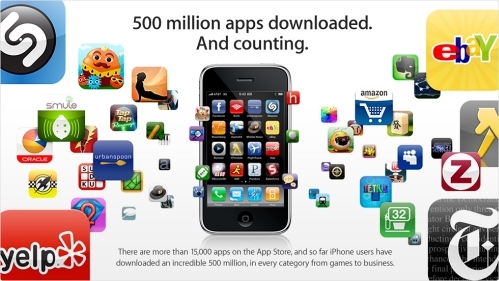
Apple's announcement of passing the 500 million mark on January 16, 2009
By the time Apple had released the iPhone 3GS on June 19, 2009, the App Store was boasting over 50,000 available applications to choose from. To size up the competition, Android held a mere 4,900, Nokia held 1,088, RIM held 1,030 and Palm held 18 respectively (According to Apple.) Even its mobile Safari browser was boasting 65 percent of all worldwide smartphone users in June 2009 and continues to hold the dominant market position through summer 2010.
Apple’s mobile platform and curated App Store have certainly held a successful journey thus far, but whether they can continue to expand with a fourth iPhone revision for another year remains to be seen. Nevertheless, we plan to dive into what merges the hardware and software details of the company’s latest smartphone iteration into a competitive smartphone to determine whether Apple stands a chance against its contenders.
Introducing the iPhone 4 – “This changes everything. Again.”
On Thursday, June 24, 2010, Apple launched the iPhone 4, the fourth hardware iteration in its successful smartphone line. Not coincidentally, this was the third time we found ourselves waiting overnight in a continually expanding line outside our local Apple Store in Southern California to be part of the new hardware release. But this particular launch was different in comparison to the past two releases, given that Steve Jobs had announced during WWDC that Apple “will take the biggest leap since the original iPhone” in 2010. While no one at the time knew with certainty what aspects of the iPhone platform Jobs was pertaining to, many came to believe that he was referring to the iPhone 4’s hardware design and new capabilities. On the other hand, some suggested that the introduction of iOS 4 and its multitasking functionality would be the great emphasis for this year. While either of these perspectives may hold some truth to what Jobs had actually implied, we believe this “biggest leap since the original iPhone” refers to a harmonious combination of the device’s new hardware capabilities, processing speed and battery life working in synchronicity with the new software improvements that iOS 4 has to offer.
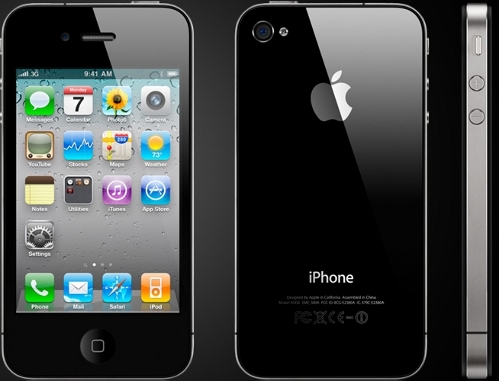
Regardless of opinion and perspective, Steve Jobs himself went on stage and made the announcement, and a bunch of folks got incredibly excited over the new phone. As a result, pre-orders skyrocketed through the roof, subsequently causing a catastrophic server meltdown and disastrous privacy breach for AT&T. Yet in spite of all this, Apple still mustered up the courage to give the device an official motto that arrogantly defies the face of PR failure and hopes to set the record straight: “This changes everything. Again.”
Retina Display – The facts and the friction
From the press shots released during WWDC, it is immediately noticeable that the physical dimensions of the screen have not changed from previous iterations of the hardware. The iPhone 4 features the same 3.5-inch display as its predecessors, but it manages to pack four times the amount of pixels into the same physical space. Right out of the box, the device sports the highest smartphone display resolution in Q2 2010 with a whopping 960x640 pixels at 326ppi (pixels-per-inch) with an 800:1 contrast ratio. Apple took the liberty of dubbing this design-win the Retina Display, claiming that the “ultra-resolution” of the screen essentially tops what is perceivable by the human eye.

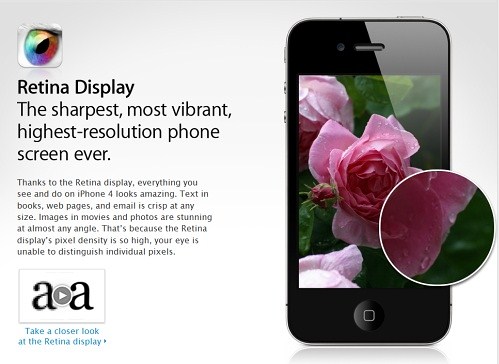
iPhone 3GS (480x320) versus iPhone 4 Retina Display (960x640)
But of course, the marketing bluff has not gone without a fair counterargument against Apple’s technology claims. Wired Magazine spoke to Dr. Raymond Soneira, president of DisplayMate Technologies and a Ph.D. in theoretical physics from Princeton University, who disagreed with Apple’s suggestion that the Retina Display exceeded the “300 pixels-per-inch” quoted as the limit for an average eye. Although he agreed that the iPhone 4’s display is “likely the best on the market,” he explained that it was inaccurate to measure the resolution of the eye in terms of pixels, because the eye actually has an angular resolution of 50 degrees per cycle.
In other words, to make an accurate comparison between the resolution limit of the human eye and pixels on a screen, the angular resolution needs to be converted into linear resolution. After calculating the conversions, Soneira concluded that a more accurate “retina display” would have a pixel resolution of 477ppi at 12 inches. “The marketing puffery is now in control,” Soneira said. “Everything that’s being said now is just this superamplified imaginary nonsense, and the only way to get people’s attention now is making more outlandish statements.
“[Market puffery] hurts companies that make good products, like Apple, because they can’t really put the specs out because everybody is lying,” Soneira explained. If you have the world’s greatest display and we launched it and put down the real scientific numbers, we’d go bankrupt because our numbers look like the worst display being made.”
Physical Dimensions, Aesthetic Changes
The iPhone 4 is also 25 percent thinner than the iPhone 3GS, measuring in at a mere 0.37 inches thick. In fact, during his WWDC 2010 keynote, Steve Jobs claimed it is currently “the thinnest smartphone on the planet. Based on what the mobile industry has revealed thus far in Q2 2010, we can verify that this statement does in fact hold true. The device no longer features the same “fat” feeling from a curved backside on the iPhone 3GS in 2009 and the iPhone 3G in 2008. For comparison’s sake, the HTC EVO 4G measures 0.47 inches thick, while the iPhone 3GS and iPhone 3G both measure 0.48 inches thick respectively.

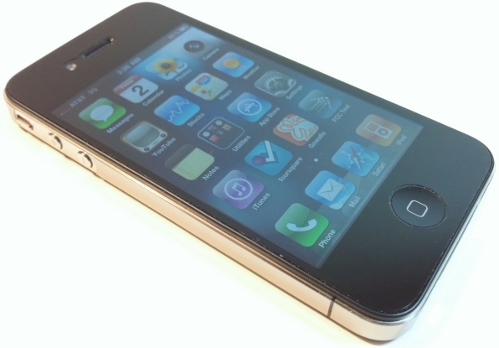
Apple was able to redesign the frame of the device to keep it at a very slim 9.3mm thickness. The front and the back of the iPhone 4 are both made out of two pieces of smooth, strengthened glass. Thanks to its recent teardown, iFixIt believes the material is
when a new iPhone is launched.
After the launch event on the morning of June 24th, were fortunate enough to have an appointment set up with the guys at Fusion of Ideas in Irvine, California to have an iPhone 4 StealthArmor shield professionally installed on our device. Serving as better device protection solution than the highly popularized InvisibleShield by Zagg, the company's StealthArmor is fabricated out of industrial grade material originally developed to protect racecar exteriors from flying asphalt while driving at high speeds. The clear shield is designed with nano-fusion technology that offers completely transparent optics - a must have for the iPhone 4 Retina Display - and is guaranteed to protect any mobile device from scratches. Interestingly enough, the full body shield also comes with custom corner and bezel protection strips that serve as an insulation layer between the iPhone 4's external antenna and the user's palm. When AnandTech did an extensive review of the iPhone 4 antenna degradation issues last week, the authors mentioned that Apple should have applied an insulative coating atop the stainless steel bezel, or perhaps even diamond vapor deposition. But now that the marketplace is fully aware of Apple's imprecise engineering imperfections (more on that in Part 2 of this review), mobile device customization and protection companies like Fusion of Ideas have responded to consumer demand with remedies that could perhaps be capable of holding a steady cellular signal while placing a call. But we will address whether or not this theory holds true in a later story.
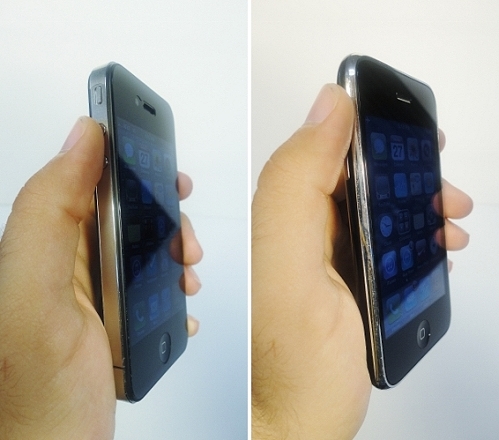
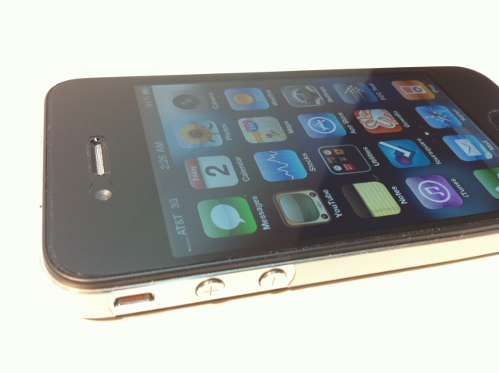
As far as weight is concerned, all iPhones to date measure in at relatively the same weight, but the density and compactness of the new iPhone 4 hardware can have a subjective variance to it that differs between users. The iPhone 4 and iPhone 3GS both weigh in at 4.8 ounces (135 grams), while the iPhone 3G weighs in at 4.7 ounces (133 grams). In comparison, the HTC Incredible weighs 4.6 ounces (130 grams), the new Motorola Droid X comes in at 5.47 ounces (155 grams), and the HTC EVO 4G comes in at 6 ounces (170 grams). To us, the iPhone 4 feels like it packs more hardware into a smaller surface area and has a noticeably denser feeling than the iPhone 3GS. This is probably due to the removal of the backside curvature being replaced by a rectangular design aesthetic that reminds us of a Gameboy Advance SP when held in the palms.
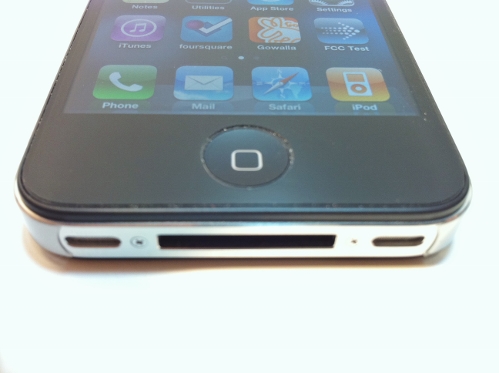
Coming Up
In the second half of our review, we will address the iPhone 4's antenna design and the controversial reception issue, Apple's new camera sensors, the dynamically clocked A4 processor, memory and internal architecture changes, iOS 4 and overall market acceptance rates so far since launch day.


